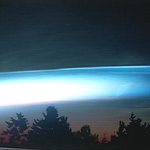2007年VOA标准英语-NASA Exploring Polar Ice Clouds(在线收听)
By Paul Sisco
Washington
20 April 2007
NASA is preparing to launch a mission to the mesosphere, a region at the top of Earth's atmosphere where mysterious night shining clouds are formed. Little is known about the mesosphere, but its unique ice clouds are being seen lower and brighter in the sky than ever before. It is causing some scientists to think human induced climate changes are reaching the edge of space. VOA'S Paul Sisco reports.
 |
| Clouds in the mesosphere are of interest to scientists |
The craft will study mysterious ice clouds way above Earth's polar regions -- clouds that can be seen from Earth with the naked eye in the night sky -- and that fascinate AIM's principal investigator James Russell.
"I became interested in these clouds when I was in Stockholm, Sweden at a conference, and I saw them for the first time. As I said before, they are very interesting, very beautiful -- iridescent blues and whites and a lot of structure in them -- and they capture your imagination," says Russell.
Little is known about these night-shining clouds, or the distant mesosphere, 80 kilometers above Earth's surface where they form, except, that they are changing.
"These clouds are changing, and they are changing in ways that we don't understand,” admits Russell. “There are more of them than ever before. They are seen at a lower latitudes than ever before and they are brighter."
Some scientists believe it may be the result of human induced climate changes.
"One possible explanation is -- that the buildup of carbon dioxide in the atmosphere at low altitudes is also occurring at high altitudes, and it's causing the atmosphere to cool. And you need cold temperatures at these very low pressures in order for these clouds to form, so there is a possible connection with global change at the Earth's surface causing global change at high altitudes."
From orbit the spacecraft's instruments will watch the clouds form, measure their composition, and the atmospheric conditions giving rise to them. Scientists want to know why icy clouds form at an altitude where it is 100-thousand times drier than the hottest deserts on Earth, and what is behind the mysterious changes in their behavior.